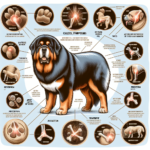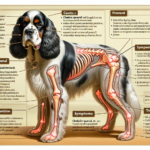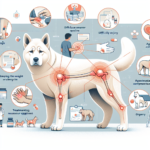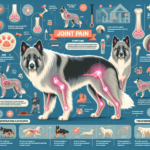Tibetan Mastiff Joint Pain: Causes, Symptoms, Prevention, and Treatment

Introduction
The Tibetan Mastiff is a majestic and ancient breed known for its impressive size, strength, and protective nature. Originating from the Himalayan regions, these dogs were traditionally used by nomadic cultures of Tibet, Nepal, and India to guard sheep from predators like wolves and leopards. With their thick double coat, imposing stature, and loyal temperament, Tibetan Mastiffs have become popular not only as working dogs but also as family companions.
Despite their robust appearance, Tibetan Mastiffs are prone to several health issues, with joint pain being a significant concern. Joint health is crucial for this breed due to their large size and active nature. Understanding the causes, symptoms, prevention, and treatment of joint pain in Tibetan Mastiffs can help owners ensure their pets lead a healthy and comfortable life.
Breed-Specific Joint Pain Risks
Genetic Predisposition
Tibetan Mastiffs are genetically predisposed to several joint-related issues, including hip dysplasia, elbow dysplasia, and arthritis. Hip dysplasia is a condition where the hip joint does not fit into the hip socket properly, leading to pain and mobility issues. Elbow dysplasia involves abnormal development of the elbow joint, causing lameness and discomfort. Arthritis, a degenerative joint disease, can also affect Tibetan Mastiffs, leading to chronic pain and stiffness.
Age-Related Risks
As Tibetan Mastiffs age, the risk of developing joint pain increases. Typically, signs of joint issues may start to appear when the dog reaches middle age, around 5 to 7 years old. However, some dogs may show symptoms earlier, especially if they have a genetic predisposition. It’s essential for owners to monitor their dogs closely as they age and be vigilant for any signs of joint discomfort.
Activity Level and Joint Stress
Tibetan Mastiffs are known for their protective instincts and high energy levels. While they are not as hyperactive as some other breeds, they require regular exercise to stay healthy. However, excessive or inappropriate exercise can put undue stress on their joints, exacerbating existing conditions or leading to new issues. Activities that involve jumping, running on hard surfaces, or sudden changes in direction can be particularly harmful to their joints.
Common Symptoms of Joint Pain in Tibetan Mastiffs
General Symptoms
- Limping or favoring one leg
- Stiffness, especially after rest or sleep
- Reluctance to move, jump, or climb stairs
- Decreased activity or playfulness
- Swelling around the joints
- Whining or showing signs of discomfort when touched
Breed-Specific Symptoms
In Tibetan Mastiffs, joint pain may manifest more prominently due to their size and weight. Owners may notice a significant decrease in their dog’s willingness to engage in activities they once enjoyed. Additionally, the breed’s thick coat can sometimes mask swelling, making it essential to pay close attention to subtle changes in behavior and movement.
When to Consult a Vet
If you observe any of the above symptoms in your Tibetan Mastiff, it’s crucial to consult a veterinarian promptly. Early diagnosis and intervention can significantly improve the quality of life for dogs suffering from joint pain. Regular veterinary check-ups are also essential for monitoring joint health and catching any issues early.
Preventive Measures for Joint Health
Exercise Recommendations
Regular, moderate exercise is vital for maintaining joint health in Tibetan Mastiffs. Activities like walking, swimming, and controlled play are excellent options. Avoid high-impact exercises such as jumping or running on hard surfaces. Instead, opt for soft ground or grass to minimize joint stress. Consistent, low-impact exercise helps keep the joints flexible and muscles strong, supporting overall joint health.
Dietary Suggestions
A balanced diet rich in essential nutrients is crucial for joint health. Consider incorporating foods or supplements that contain glucosamine, chondroitin, and omega-3 fatty acids, which are known to support joint function. High-quality commercial dog foods often include these nutrients, but you can also consult your veterinarian for specific dietary recommendations tailored to your dog’s needs.
Weight Management
Maintaining a healthy weight is one of the most effective ways to reduce joint stress in Tibetan Mastiffs. Excess weight puts additional pressure on the joints, exacerbating pain and discomfort. Regular exercise, portion control, and a balanced diet are key to keeping your dog at an optimal weight. Consult your veterinarian for specific weight management guidelines for your Tibetan Mastiff.
Early Screening and Monitoring
Early screening for joint issues can help catch problems before they become severe. Regular veterinary check-ups should include joint assessments, especially as your dog ages. X-rays and other diagnostic tools can help identify conditions like hip or elbow dysplasia early on, allowing for timely intervention and management.
Treatment Options for Joint Pain
Non-Surgical Treatments
Non-surgical treatments for joint pain in Tibetan Mastiffs include medications, physical therapy, and lifestyle adjustments. Anti-inflammatory drugs and pain relievers can help manage symptoms, while physical therapy can improve mobility and strengthen muscles around the joints. Lifestyle adjustments, such as providing a comfortable bed and avoiding high-impact activities, can also alleviate joint pain.
Surgical Options
In severe cases, surgical intervention may be necessary. Common surgical options for joint pain include hip replacement, arthroscopy, and joint fusion. These procedures can significantly improve the quality of life for dogs with debilitating joint issues. However, surgery should be considered a last resort after exploring all non-surgical options.
Alternative Therapies
Alternative therapies like acupuncture, hydrotherapy, and massage can also benefit Tibetan Mastiffs with joint pain. Acupuncture involves inserting thin needles into specific points on the body to relieve pain and improve function. Hydrotherapy, or water therapy, provides low-impact exercise that can strengthen muscles without stressing the joints. Massage can help reduce muscle tension and improve circulation, promoting overall joint health.
Lifestyle and Management Tips
Daily Care Routine
A consistent daily care routine can help manage and alleviate joint pain in Tibetan Mastiffs. This routine might include gentle exercise, a balanced diet, and regular grooming to monitor for any changes in mobility or discomfort. Providing a comfortable, supportive bed and ensuring your dog has a warm, dry place to rest can also make a significant difference.
Modifying the Home Environment
Making your home more comfortable for a dog with joint pain involves several modifications. Consider installing ramps to help your dog navigate stairs or get onto furniture without jumping. Orthopedic beds provide better support for aching joints, and non-slip mats can prevent falls on slippery surfaces. Ensuring easy access to food, water, and favorite resting spots can also reduce strain on your dog’s joints.
Long-Term Management
Long-term management of joint pain involves regular veterinary check-ups, consistent exercise, and a balanced diet. Monitoring your dog’s weight and adjusting their activity level as needed can help manage symptoms. Additionally, staying informed about new treatments and therapies can provide more options for managing your dog’s joint health over time.
FAQs About Tibetan Mastiffs and Joint Pain
What are the early signs of joint pain in Tibetan Mastiffs?
Early signs of joint pain include limping, stiffness, reluctance to move, and decreased activity. If you notice any of these symptoms, consult your veterinarian for a thorough examination.
Can joint pain in Tibetan Mastiffs be prevented?
While genetic predispositions cannot be entirely prevented, maintaining a healthy weight, providing appropriate exercise, and ensuring a balanced diet can significantly reduce the risk of joint pain.
Are there specific foods that can help with joint health?
Yes, foods rich in glucosamine, chondroitin, and omega-3 fatty acids can support joint health. Consult your veterinarian for specific dietary recommendations tailored to your dog’s needs.
When should I consider surgery for my dog’s joint pain?
Surgery should be considered when non-surgical treatments are no longer effective, and your dog’s quality of life is significantly impacted. Consult your veterinarian to discuss the best options for your pet.
Are alternative therapies effective for joint pain in Tibetan Mastiffs?
Alternative therapies like acupuncture, hydrotherapy, and massage can be effective in managing joint pain. These treatments can complement traditional methods and provide additional relief for your dog.
Conclusion
Joint pain is a common issue in Tibetan Mastiffs, but with proper care and management, you can help your dog lead a comfortable and active life. Understanding the causes, symptoms, prevention, and treatment options is crucial for maintaining your dog’s joint health. Regular veterinary check-ups, a balanced diet, appropriate exercise, and weight management are key components of a comprehensive joint health strategy. By taking proactive measures and staying informed, you can ensure your Tibetan Mastiff enjoys a happy and healthy life.




